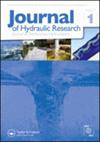Numerical modelling of local scour around a spur dike with porous media method
IF 1.7
3区 工程技术
Q3 ENGINEERING, CIVIL
引用次数: 0
Abstract
ABSTRACT A 3D numerical model is developed to investigate the flow motion and sediment transport around a spur dike. In this model, fluid motion is described by the Navier–Stokes equations, adopting large eddy simulation to capture turbulent transport and dissipation. The spur dike and sand bed are treated by the porous media method. The suspended load concentration and the bed load transport rate is calculated separately, and then the bed variation is updated using the mass-balance equation. A series of flume experiments are employed to validate the model’s performance before being applied for the case of partially emergent spur dikes and submerged spur dikes, respectively. Detailed analyses on the spatial-temporal variation of flow intensity, sediment concentration and shapes of scour holes are made, based on which some innovative findings are discussed such as the scouring process patterns, as well as the influence of flow conditions on the maximum scour depth and location, and then useful engineering suggestions are provided to improve structural safety.基于多孔介质法的直堤局部冲刷数值模拟
摘要建立了一个三维数值模型,研究了直堤周围的水流运动和泥沙输运。该模型采用Navier-Stokes方程描述流体运动,采用大涡模拟来捕捉湍流输运和耗散。采用多孔介质法处理直堤和砂层。分别计算悬浮荷载浓度和层载输运率,然后利用质量平衡方程更新层态变化。通过一系列水槽试验验证了模型的性能,然后分别将模型应用于部分突出和淹没的直堤。详细分析了水流强度、含沙量和冲刷孔形态的时空变化规律,在此基础上讨论了冲刷过程模式、水流条件对最大冲刷深度和位置的影响等一些创新发现,并提出了提高结构安全的有益工程建议。
本文章由计算机程序翻译,如有差异,请以英文原文为准。
求助全文
约1分钟内获得全文
求助全文
来源期刊

Journal of Hydraulic Research
工程技术-工程:土木
CiteScore
4.90
自引率
4.30%
发文量
55
审稿时长
6.6 months
期刊介绍:
The Journal of Hydraulic Research (JHR) is the flagship journal of the International Association for Hydro-Environment Engineering and Research (IAHR). It publishes research papers in theoretical, experimental and computational hydraulics and fluid mechanics, particularly relating to rivers, lakes, estuaries, coasts, constructed waterways, and some internal flows such as pipe flows. To reflect current tendencies in water research, outcomes of interdisciplinary hydro-environment studies with a strong fluid mechanical component are especially invited. Although the preference is given to the fundamental issues, the papers focusing on important unconventional or emerging applications of broad interest are also welcome.
 求助内容:
求助内容: 应助结果提醒方式:
应助结果提醒方式:


